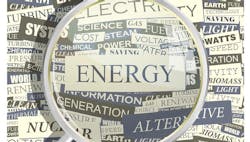The coronavirus-induced economic slowdown and the recent gyrations of oil prices has many refineries and chemical plants running at reduced throughputs. The impact on profitability and employment has become headline news. However, much less has been said about the impact on energy efficiency.
Energy intensity is the amount of energy used per unit of production — i.e., Energy Intensity = Energy Consumption/Production.
Low energy intensity corresponds to high energy efficiency; as the equation makes clear, this is achieved with low energy consumption and high production rates. This simple fact produces many ramifications — one of the most obvious is the adverse impact of cuts in production rate.
Chemical plants and refineries are designed to run at maximum efficiency at their nameplate capacity. As production falls in continuous processes, energy consumption doesn’t drop proportionately. Many reasons for this exist, with the majority linked to control methods, equipment constraints, and leaks and losses.
Most flow control systems are inherently inefficient. Two common examples involving centrifugal pumps illustrate this point. In so-called “bypass control,” the flow rate to the downstream consumer is regulated by recycling fluid from the pump discharge either to the pump suction or to a feed drum ahead of the pump. When the flow required by the downstream consumer declines, the recycle flow increases. However, the flow through the pump and, hence, the pump’s energy consumption remain essentially constant. Because energy consumption stays the same while production goes down, energy intensity increases.
In the second example, “throttle control,” a valve in the pump discharge line adjusts the flow. The valve closes to reduce the flow. This imposes backpressure on the pump, which has to deliver a higher discharge pressure. This, in turn, demands more energy per unit of flow. In addition, both the pump and its driver (usually an electric motor) move away from their design points to new operating points, which are invariably less efficient. The result, once again, is an increase in energy intensity — although the increase isn’t usually as large as it would be with bypass control.
In contrast to these examples, variable speed control can, in some cases, reduce energy intensity as flow rate goes down. However, this is typically more expensive to implement.
Control systems also can cause a rise in energy intensity as throughput drops in distillation columns. The flows of reflux streams and stripping steam often are set based on nameplate throughput, then held constant. Consequently, when feed rates drop, there isn’t a commensurate fall in energy consumption. Modifying flow control systems to maintain a constant reflux ratio or stripping steam ratio — or, better, to keep product specifications constant using online chemical analysis — can correct this problem.
To overcome minimum turndown limits in distillation columns, boilers, furnaces, and other equipment, requires energy and minimum flow restrictions in piping. For example, as a distillation column reaches its turndown limit, it may make sense to increase its reflux ratio to maintain liquid and vapor traffic instead of reducing it, as discussed in the previous paragraph. When boilers reach their turndown limits, many sites either vent steam or, alternatively, deliberately use steam inefficiently within their processes to avoid a visible vent. When a flow rate approaches the minimum limit in a pipe, prudence may dictate recycling fluids, which increases pumping costs.
Heat losses through piping and vessel walls, steam leaks, and condensate are insensitive to throughput, so they become a larger percentage of energy consumption as production falls, causing energy intensity to rise.
With the exception of some of the simpler control issues, resolving most of these problems usually requires significant investment. However, in some cases, operating changes also can provide improvements, especially where multiple pieces of equipment run in parallel. For example, it may be possible to shut down one process train in a multi-train plant, one or two pumps or fans in a large cooling water system, or one or two boilers in a large steam system. However:
• The operating changes must not compromise safety or reliability.
• You must consider system interactions. For example, shutting down a cooling water pump eliminates the energy use in that pump, but the reduction in flow may adversely affect the energy intensity of equipment that uses the cooling water (e.g., refrigeration units).
About the Author

Alan Rossiter
Energy Columnist
Alan Rossiter is a former contributor for Chemical Processing's Energy Saver column. He has more than 35 years of experience in process engineering and management, including eight years in plant technical support, design and research with Imperial Chemical Industries (ICI, United Kingdom) and nine years in energy efficiency and waste minimization consulting with Linnhoff March, before starting his own business. In 2019 he joined the University of Houston as Executive Director, External Relations for UH Energy. He is a chartered engineer (U.K.) and a registered professional engineer in the state of Texas. His latest book, Energy Management and Efficiency for the Process Industries, coauthored with Beth Jones, was published by John Wiley & Sons in 2015. He is a Fellow of the American Institute of Chemical Engineers and a Past Chair of the South Texas Section of the AIChE.
